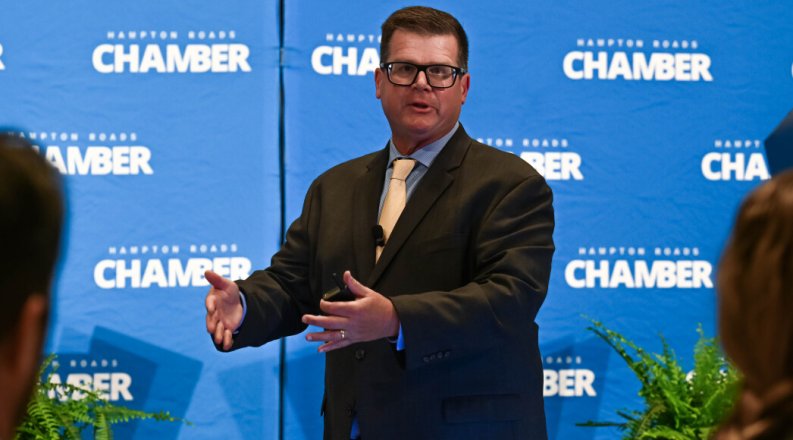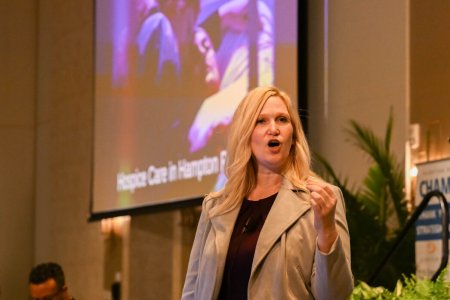There is plenty of good news about the Hampton Roads economy. The steep declines triggered by the pandemic are largely in the rear-view mirror. Regional economic growth has vigorously rebounded, the unemployment rate is close to pre-pandemic levels and our population continues to grow, albeit slowly.
But, as the 24th annual State of the Region Report produced by Old Dominion University’s Dragas Center for Economic Analysis and Policy points out, we can reach greater heights if we can overcome some remaining issues.
Among those challenges are:
- Even with its improving economic fortunes, Hampton Roads lags many of its peer and aspirant metropolitan areas.
- The difficulty of finding the right talent at the right time continues to limit employers’ ability to expand.
- Housing remains relatively expensive in the region when compared to incomes.
- The region still needs to speed up the pace of regional cooperation and eliminate administrative duplication.
- The economy must further diversify to become less reliant on federal government spending, which accounts for four out of every 10 dollars of economic activity.
The region’s economic recovery from the pandemic has been impressive. Robert M. McNab, director of the Dragas Center and lead author of the report, noted that the region is on pace for three consecutive years of economic growth, something that hasn’t happened since before the Great Recession of 2007-09.
“If we can surmount the challenges that are facing us, some of which are outside of our control, then we project we’ll grow again in 2024,” McNab told an audience of more than 700 civic and industry leaders during a presentation held in partnership with the Hampton Roads Chamber of Commerce in downtown Norfolk on Oct. 3.
Why is this important?
Regional growth was particularly lackluster in the decade after the Great Recession. The report notes that from 2001-2019, our economy grew by just 15.8%, compared with 35.7% for the state and 43.5% for the nation.
“But all of a sudden, we’ve had a sharp uptick in activity in ’21, in ’22, in ’23 and, if Congress can get its act together – which is questionable – in 2024,” McNab said. “That means we are setting the conditions for growth to make up for lost ground of the previous decade.”
Yet, while civilian and individual employment finally inched past its pre-pandemic peak this April, it ranks near the bottom when compared with selected peer and aspirant metro areas, such as Richmond, Raleigh/Cary, N.C., and Jacksonville, Fla.
Part of the reason is the region’s reliance on federal spending. McNab and Vinod Agarwal, economics professor and deputy director of the Dragas Center, both stressed the need to leverage sectors where jobs not tied to the federal government are growing in Hampton Roads – maritime, renewable energy, healthcare and health research, and unmanned systems, for instance.
“If we can lean into these sectors that are growing, we could address the issue of our dependence with regards to the federal government,” McNab said.
Hampton Roads’ “Three Pillars” – defense, the Port of Virginia, and the hospitality and tourism industry – significantly bolstered the local economy. Defense spending locally ($27.1 billion in 2023) and the amount of cargo moved through the port reached record highs. The hospitality and tourism industry outperformed many markets within the state and nationally.
Cargo traffic at the port hit 26.2 million tons in 2022, an increase of 19.2% over pre-pandemic levels in 2019.
“’21 and ’22 were banner years for the Port of Virginia, regardless of which measure of performance you look at,” Agarwal said. This was largely a result of the pandemic, he explained, when consumers shifted much of their spending from services to durable goods.
In 2023, with inflation, rising interest rates and consumers spending more on services, cargo moving through the port has declined only slightly compared with other U.S. ports.
And the port’s future looks promising.
“Shipping companies realize the benefits of having a big channel which is open is open 24/7,” he said. “With the channel’s widening and deepening more, we would expect to see reasonable growth coming in the next few years.”
Barbara Blake Gonzalez, executive director of the Monarch Internship and Co-Op Office and former chief administrative officer of the Dragas Center, discussed hospice care in the U.S. and Hampton Roads.
She pointed out that more than 1.7 million Medicare patients received hospice care in 2020, including nearly 40,000 in Virginia. Approximately 7,000 Hampton Roads residents 65 or older died in hospice care that year. Typically, this is often intermittent care consisting of daily and/or weekly visitations that last less than an hour.
Over the past several decades, the hospice care industry has transitioned to a for-profit sector. Currently, 66% of hospice care agencies nationally operate on a for-profit basis and may charge more for their services. A substantial driver of this trend has been the growth of large publicly traded for-profit hospice chains, which has raised quality concerns among some policymakers and patient advocates, the report noted.
Blake said the latest national data indicates that Hampton Roads is one of the largest Metropolitan Statistical Areas without a freestanding hospice house. Unlike hospice services affiliated with or operated within a hospital or healthcare system, freestanding or independent hospices operate as separate entities that exclusively serve individuals within six months of death.
Daily inpatient hospice need locally is estimated at 45 beds per day.
The Dozoretz Hospice House of Hampton Roads, which is aiming to open in the spring of 2024, will help to address this. The $9.56 million, 12-private bedroom complex in Virginia Beach will be the region’s first freestanding facility. It will be staffed by professionally licensed medical personnel and trained volunteers around the clock.
The need for facilities like this will only grow as our population ages.
“We need to think about ‘Does Hampton Roads have enough of the providers to help with those individuals who have come to the end of their life?’” Blake said. “Do we have enough spaces? How do we support them? Now, think about the math. This is going to be a 12-bed unit. And we’re talking about thousands of people in Hampton Roads that would need these specialized services.”
The State of the Region Report also contains chapters about veterans in Hampton Roads, public transportation, the pros and cons of subsidizing private facilities and the Virginia Museum of Contemporary Art. You can view the presentation here. The full report, as well as previous State of the Region reports, are available at this link.
Above: Robert M. McNab, economics professor and director of the Dragas Center for Economic Analysis and Policy, addresses an audience of more than 700 at the 24th annual State of the Region presentation. Photo Chuck Thomas/ODU





